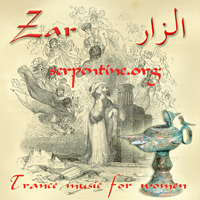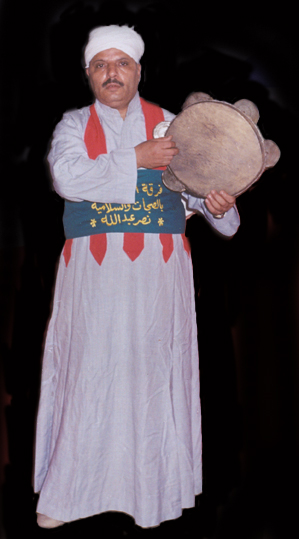Serpentine Communications
4930 Saint Elmo Ave. Bethesda MD 20814
Tel: (301) 654-2224 Fax: (301) 656-1658

| Contact Artemis |

| Contact Yasmin |

The
Zar
 Please remember, this is NOT exorcism. For a mini-documentary . The ceremony is diagnostic
in character. Zar related illnesses are considered to be inflicted
by the spirits as a way of getting their hosts' attention. Once their
presence has been acknowledged, they usually form a symbiotic relationship
with their chosen human. The cult takes on different forms, depending
on which country it is practiced in. The Egyptian Zar for example, is unique from the Sudanese, even though it originated there. A Zar ceremony is used to identify the spirit causing
the illness. This is done through music. When the musicians play a rhythm associated with a woman's
possessing spirit she will feel an uncontrolable urge to get up
and dance. The Sheikha, or Zar leader, will then communicate with the spirit and try to negotiate an amicable settlement..
Please remember, this is NOT exorcism. For a mini-documentary . The ceremony is diagnostic
in character. Zar related illnesses are considered to be inflicted
by the spirits as a way of getting their hosts' attention. Once their
presence has been acknowledged, they usually form a symbiotic relationship
with their chosen human. The cult takes on different forms, depending
on which country it is practiced in. The Egyptian Zar for example, is unique from the Sudanese, even though it originated there. A Zar ceremony is used to identify the spirit causing
the illness. This is done through music. When the musicians play a rhythm associated with a woman's
possessing spirit she will feel an uncontrolable urge to get up
and dance. The Sheikha, or Zar leader, will then communicate with the spirit and try to negotiate an amicable settlement..
Even non-initiated Egyptians confuse what the cult is all about. They will call it "spooky" exorcism (Hossam Ramzy on his rhythm CD) or think that it is to "ward off evil spirits" (from the liner notes of Peter Gabriel's Passion of the Christ - track 8 is entitled Zaar.)
 Another common misconception about the Zar is how the dance is performed, what Westerners
refer to as 'trance dancing'. The initial dance is in fact mainly a head toss, forward and back, while the dancer walks in a circle around a central alter. The head movements are accompanied by a forward bending at the waist. But once the music grabs them, the participants tend to stand facing the musicians and move in place. Often individual spirits are associated
with their own distinctive dances. These generally reflect a spirit's regional origin or its occupation. The Zar should not to be confused with the North African guedra, which is also a possession dance.
Another common misconception about the Zar is how the dance is performed, what Westerners
refer to as 'trance dancing'. The initial dance is in fact mainly a head toss, forward and back, while the dancer walks in a circle around a central alter. The head movements are accompanied by a forward bending at the waist. But once the music grabs them, the participants tend to stand facing the musicians and move in place. Often individual spirits are associated
with their own distinctive dances. These generally reflect a spirit's regional origin or its occupation. The Zar should not to be confused with the North African guedra, which is also a possession dance.
Unfortunately images of real Zar ceremonies are hard to find. There are a number of Egyptian movies that have scenes from a Zar in them. (Al-Ins wal-Ginn is a favorite). But similar to Hollywood, the Egyptian movie industry bends reality to suit its plot line. Documentary footage of a hadra - the weekly gathering of cult initiates - can be seen on the National Geographic report about Lucy, aired in 1991. In an interview she reveals that the Zar played a large role in inspiring her to dance.
"I started dancing when I was 12 years old. Since I can remember, whenever I heard music my body would just start to move. I couldn't control it. I used to love it when the old women got together for a zar. A zar was called when someone was possessed by evil spirits. If you were mad, or sad, or upset, that's how you would get it out. As a young girl, when I went to the zar, I was always very affected by it. I would get so exhausted that I would collapse and fall. I realized that the music took me over. The beat can get inside of you and make you crazy. The rhythm gets you. You know, like when you're listening to Western rock music, you get hysterical. You have to get up and dance. You can't stop moving. " Lucy
 Aisha Ali also has black and white footage of a hadra in her 1977 video about the ghawazee. More images of real Zar ceremonies and hadra can be seen in the video I put together for my Zar Workshop.
Aisha Ali also has black and white footage of a hadra in her 1977 video about the ghawazee. More images of real Zar ceremonies and hadra can be seen in the video I put together for my Zar Workshop.
Even though images of the ceremony are hard to find, the Zar is very much a part of lower class Egyptian life, along with the Ginn (or genies as westerners call them). Some cabaret dancers have even encorporated Zar inspired numbers into their shows. According to Ibrahim Farrah, Nadia Gamal was the first to do this in 1968. I have also found television footage of Shoo Shoo Amin performing a zar piece in the 1980s and Aiza Sharif doing the same. Even famous singers, such as Ahmad Adawia, have written hit songs about women who believe in the Zar. Have you ever wondered what the Salamaat Om Hassan were talking about?
Link to purchase authentic zar music from Sands of Time - ZAR.
RESOURCES
There are a number of web pages about the Zar. Here are some that I think give an accurate view of this healing cult.
-
She did her homework.
-
- an American dancer's point of view
-
Zar thread - Egyptsearch.com - very good discussion by NON dancers
-
and my with the leader of the Awlad Abou al-Gheit Zar group, the most well-known group in Egypt.
-
- and a prewired disposition for altered mental states.
There are several extraordinary books about the subject - one covers the zar in Sudan, another looks at possession healing in Egypt. The third is about the Zar cult in Ethiopia. The books are PhD thesises, so they can be difficult reading for those not initiated into the vocabulary of anthropology. They are nevertheless fascinating studies about the women who practice this cult and the social conditions they live in.
-
- Egypt
-
- Sudan
-
- Ethiopia
Magazine and newspaper articles I was able to find:
- Arabesque issues from 1978: Volume III: #5, #6, Volume IV: #1, #2
- New York Times article : In Cairo , Dance of a Cult Pacifies Demons; To Placate the Genie
By CHRISTOPHER S. WREN Special to The New York Times. New York , N.Y. : Jul 9, 1979 . pg. A4, 1 pgs. Text Word Count 1186